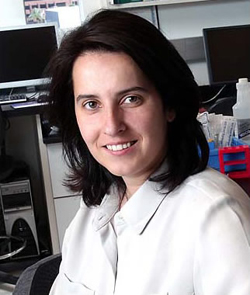Dr. Susana Martinez-Conde
The ScienceDaily article Researchers Resolve 40-year Eye Movement, Visibility Controversy said
“For more than 40 years, a scientific controversy has raged over whether microsaccades, rapid eye movements that occur when a person’s gaze is fixated, are responsible for visibility.Research conducted at Barrow Neurological Institute in Phoenix has recently resolved the debate, establishing that microsaccades are indeed responsible for driving 80 percent of our visual experience.
Even when eyes are fixated carefully on an object, they continue to make tiny movements called fixational eye movements. These movements cause nearly constant stimulation of the retina. ‘If our eye was perfectly still during fixation, the world would quickly fade from view due to the fact that the neurons in our eyes and brain quickly adapt to non-changing stimulation,’ said lead researcher Dr. Susana Martinez-Conde.”
Susana Martinez-Conde, Ph.D. is director of the Martinez-Conde Laboratory of Visual Neuroscience at the Barrow Neurological Institute.
Susana is interested in the aspects of the neural code that relate to our visual perception. One of the ways she addresses this is by correlating the eye movements that occur during visual fixation with the spike trains that they provoke in single neurons. Since visual images fade when eye movements are absent, it makes sense that the patterns of neural firing that correlate best with fixational eye movements are important to conveying the visibility of a stimulus. She has found that bursts of spikes are better related to fixational eye movements than singles spikes alone. This suggests that bursts of spikes are more reliable signals than are single spikes.
Susana coedited Visual Perception Part 1, Volume 154: Fundamentals of Vision: Low and Mid-Level Processes in Perception (Progress in Brain Research) and Visual Perception Part 2, Volume 155: Fundamentals of Awareness, Multi-Sensory Integration and High-Order Perception (Progress in Brain Research) (Progress in Brain Research), coauthored Mind tricks – Cognitive scientists take a lesson from magicians, Windows on the mind, Microsaccades counteract visual fading during fixation, and Novel visual illusions related to Vasarely’s “nested squares” show that corner salience varies with corner angle, and authored Fixational eye movements in normal and pathological vision. Read her full list of publications!
She completed her PhD in neuroscience from the University of Santiago de Compostela in Spain in 1996, followed by postdoctoral studies in the Harvard Medical School laboratory of Nobel Laureate David Hubel (Nobel Prize in Physiology or Medicine, 1981). Her research focuses on the neurobiology of visual awareness, perception, illusions and art and her work has been published in top academic journals as well as in popular science magazines, such as Scientific American. Susana has given lectures to several arts organizations and museums. She has also been recently featured for her lab’s research and contributions in The Wall Street Journal, The New York Times, The New Yorker, Vanity Fair, Discover Magazine, and Nature.
Susana is a Founding Member and Executive Chair of the Neural Correlate Society, which hosts the Annual Best Visual Illusion of the Year contest. “The contest is a celebration of the ingenuity and creativity of the world’s premier visual illusion research community. Visual illusions are those perceptual experiences that do not match physical reality.” She was elected to the Board of the Association for the Scientific Study of Consciousness (ASSC) in 2005 and cochaired the 11th Annual Meeting of the ASSC in June 2007.
Watch her demos Alternating Brightness Star and Visual Fading.
